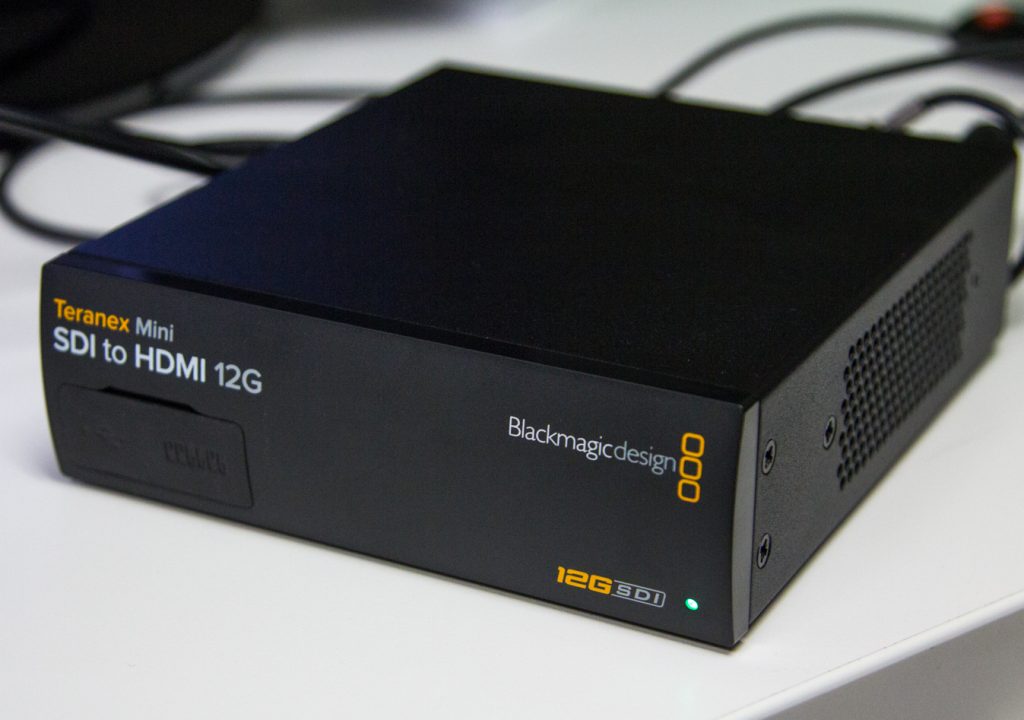Getting our grummy hands on Blackmagic’s new Teranex Mini Converter.
I’ll start with one undeniable fact: I am not a broadcast engineer. I will approach the Blackmagic Teranex Mini review from the perspective of a cameraman, or DOP to some.
Why the hell do we need converters? A question I often ask myself before the reality of broadcast crushes into view. With so many different formats, devices, cameras, archive equipment and everything else making the world of broadcast and film continue to revolve, converters are the gravity keeping it all working together. For example, converters might help an editor ingest older archive footage into their NLE. So, what makes Blackmagic’s new Teranex Mini converters special?
First, they work from SD, HD, and up to 2160 UHD. Second, they are relatively inexpensive, and the new Teranex design opens up to more rack-mountable solutions. Third, they have XLR audio connections instead of 1/4 inch audio connections. In my hands, I used the Teranex Mini 12G-SDI to 12G-HDMI as a way to power a less expensive HDMI Monitor on set. From a Blackmagic URSA shooting and outputting 4K to a cheap HDMI Monitor. Does this make sense? Why send a 4K SDI output routed through converter and to a HD monitor? In my experiments, the end result was sharper and more pleasing to view, but I’m not always going to have a cheap 1080 HDMI monitor. There is a 4K HDMI monitor in my future and I see my URSA – Teranex Mini Converter being my on-set solution to large monitor viewing while also possibly saving me a little $ in the end.
For $495, I can power any HDMI client monitor without breaking the bank. With the relatively small size, the Teranex mini seems to be easy to mount onto the back of a Monitor so both, Monitor and Converter, are forever together. Plus, as I pushed 4K to the 1080 monitor the footage looked better than straight 1080 HD. The Client may not be watching a 4K signal on a 4K Monitor, but 4K scaled down to HD still looks better than HD to HD. I don’t know why it works that way, but it does, and clients like seeing their $ at work.
But the Teranex Mini power does not stop there. For an additional $85 one can add a smart panel to the Teranex mini. This smart panel gives you the ability to see what’s going through the converter with the built-in LCD Screen. This eliminates the guess work what’s being converted. Plus, the menu navigation is supposed to be easier. Unfortunately, Blackmagic did not send me a smart panel to test so I cannot speak to how well it works. In theory, it looks like a great solution when running several converters at once. I mean, I’d hate to get confused when I could have a visual option letting me glance at a screen and see what’s being converted. Now, check out the Blackmagic Teranex Mini’s 9 different flavors: SDI to HDMI 12G, HDMI to 12G SDI, SDI to Analog 12G, Analog to 12G SDI, SDI to 12G Audio, Audio to 12G SDI, 12G SDI to Quad SDI, Quad SDI to 12G SDI, and a SDI Distribution 12G.
Also, in all of those options above you’ll see Optical Fiber versions which cost around $895. While more expensive, these give us the ability to convert optical six different ways: Optical to 12G-HDMI, HDMI to 12G Optical, Optical to 12G Analog, Analog to 12G Optical, Optical to 12G Audio, and Audio to 12G Optical.
What really impresses me, and remember I’m not an engineer, is how these Teranex mini converters work together when rack mounted. By placing the cooling fan ports on the sides, the Teranex Mini’s, when mounted side-by-side, can work together to pull air through to cool themselves.
Is this the best solution for you? Maybe. For me, the 12G-SDI to 12G-HDMI makes sense. I could also see a Quad-SDI to 12G-SDI being a smart investment as well. To learn more about Blackmagic’s Teranex Mini Converters go here.

